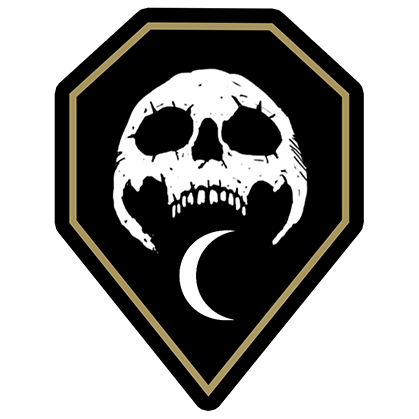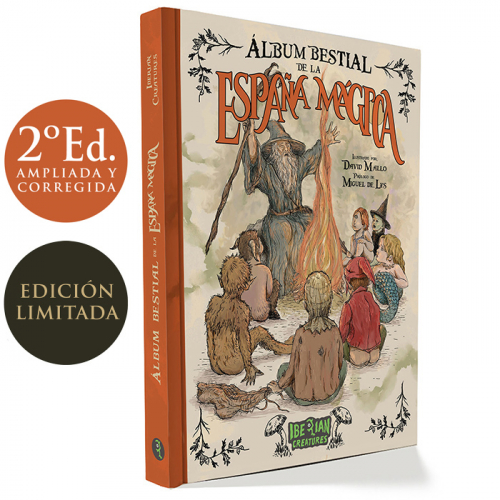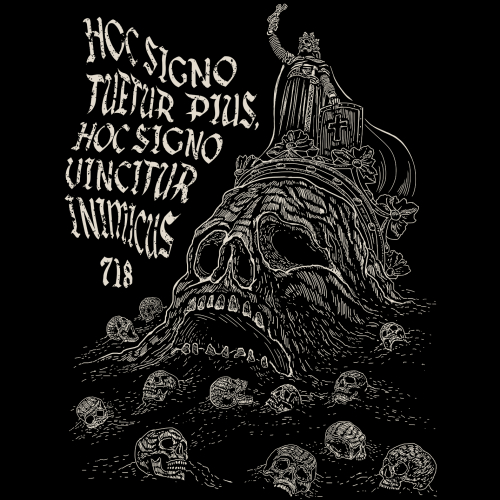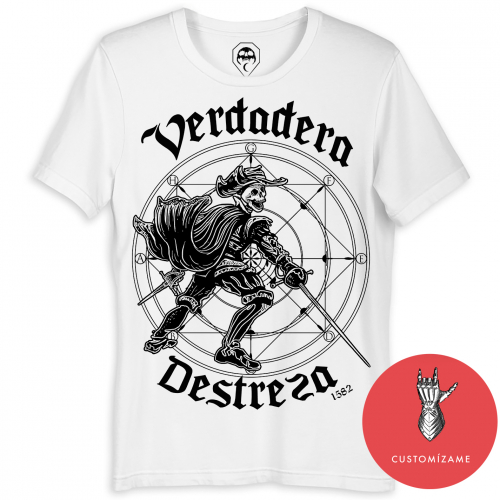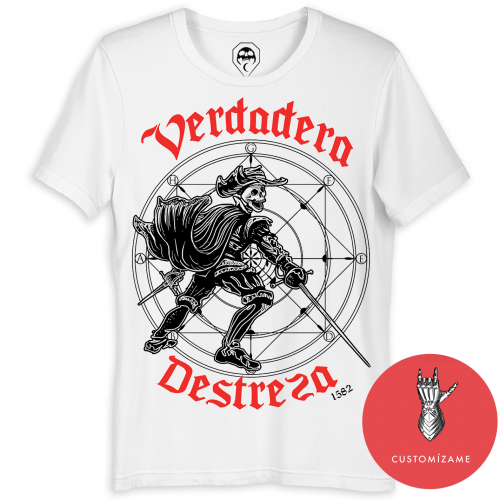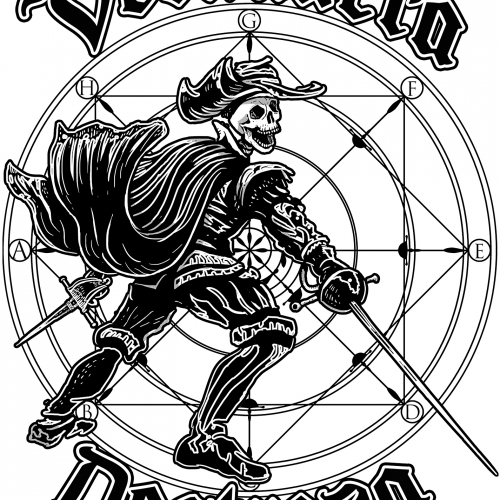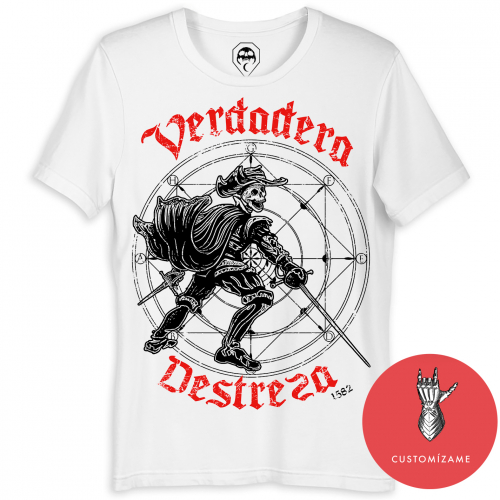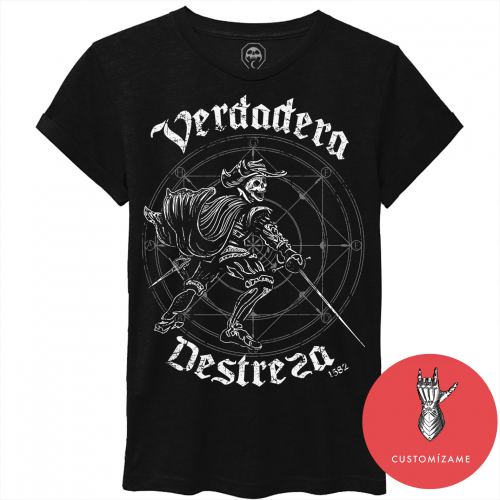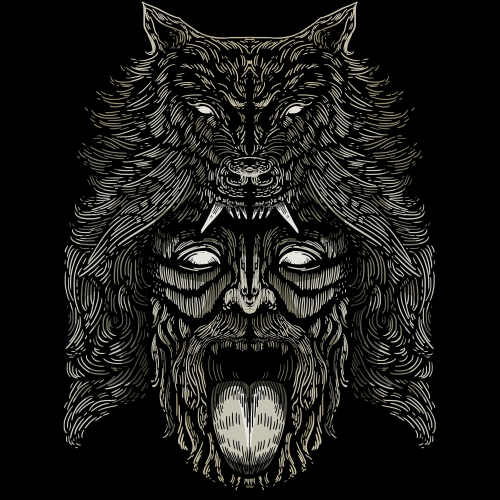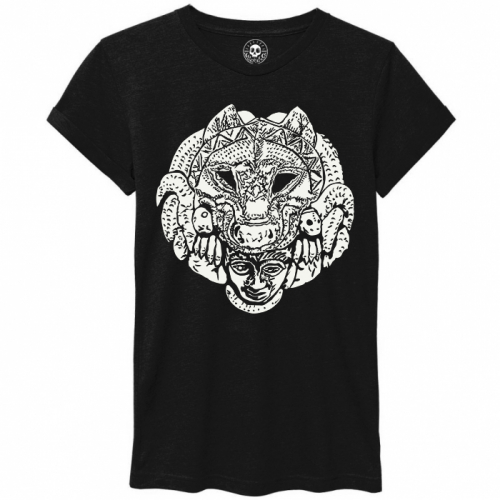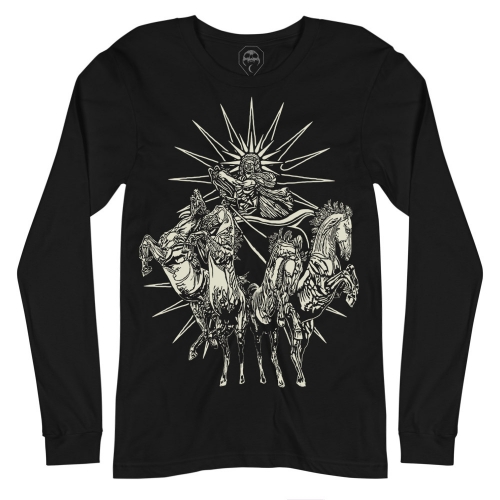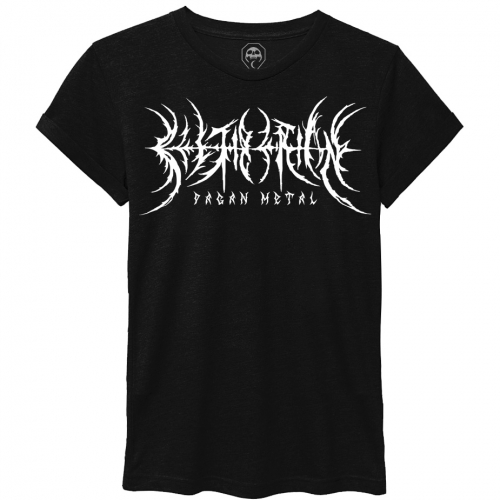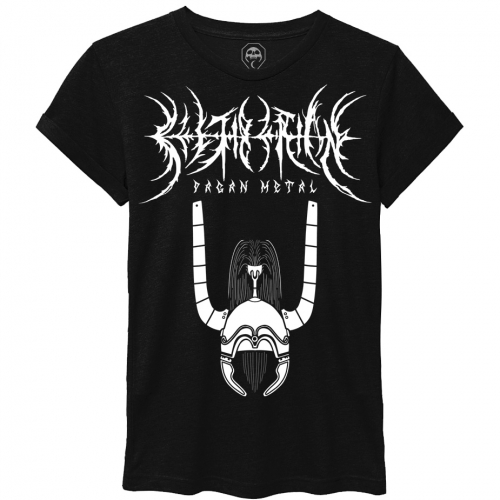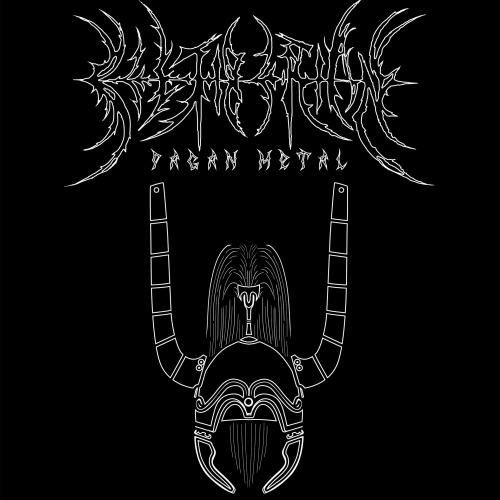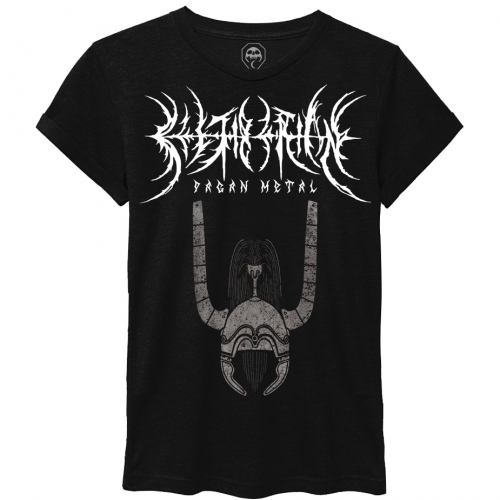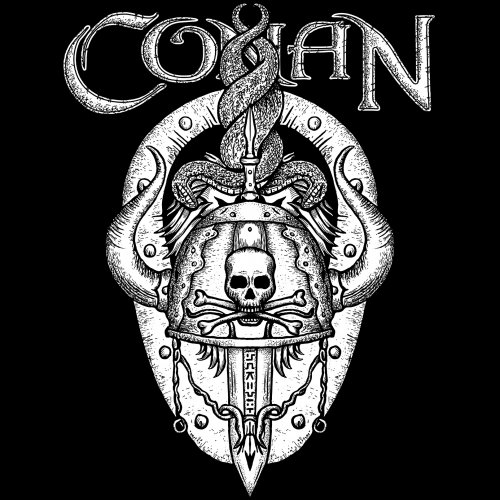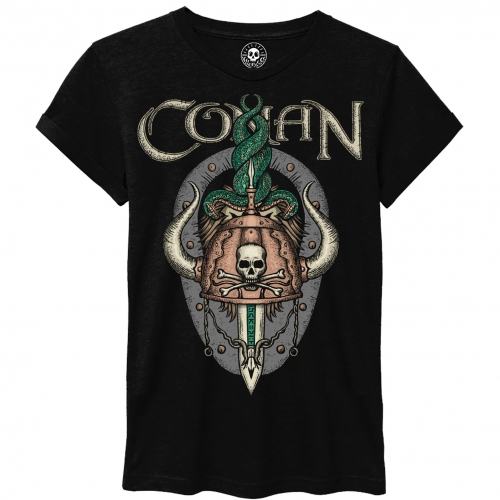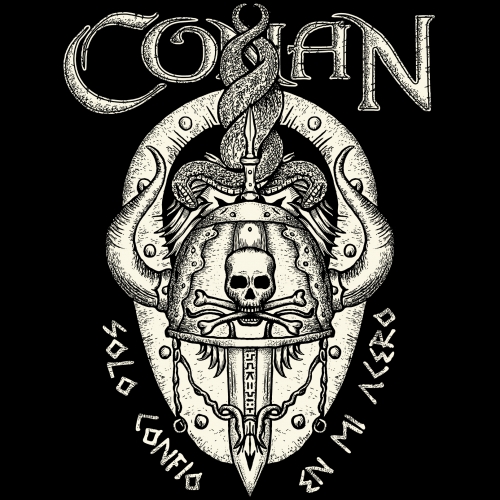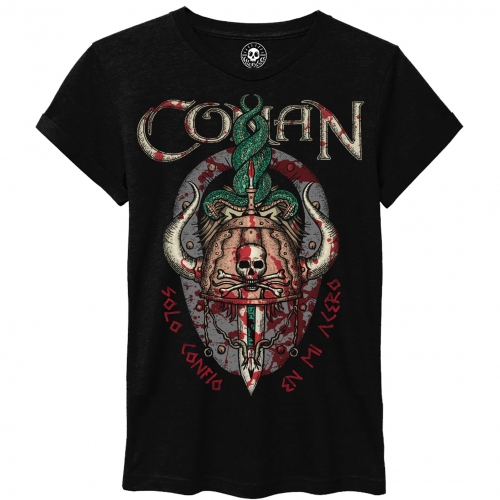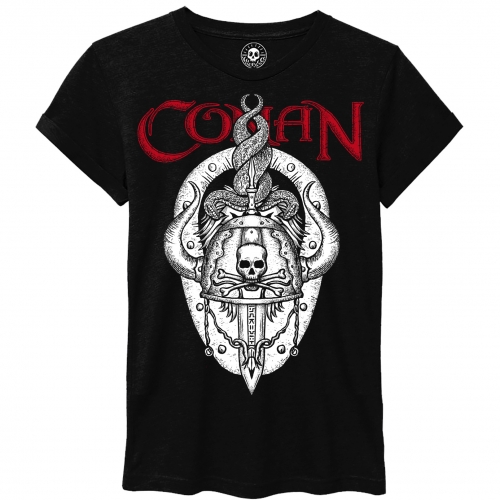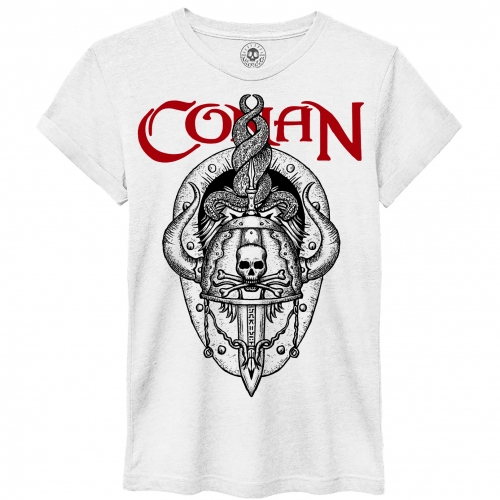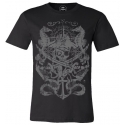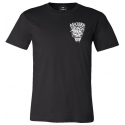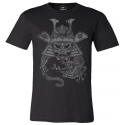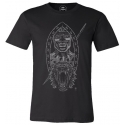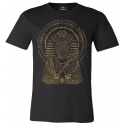There are 67 products.
Deo Vaelico - Black T-shirt
«The war reached us all, in the heat of battle, we well knew the sovereign wolf God and his ferocious consecrated warrior brotherhoods that, through magical rituals, acquired fury for combat, assuming the faculties of the wolf and after his death triumphant, Vaélico, thus referred to by the Vetones, accompanies them on their journey to the beyond.»
- New
copy of Wolf warrior - Black T-shirt
The Iberians gained fame for their fighting prowess, but their writing systems, their trade, and their art show that they were much more than great warriors. Their mother tongue "Iberian" was spoken from the Hérault River (France) to Porcuna (Jaén) and they left thousands of inscriptions written in an original alphabet of signs that was a mystery for centuries that little by little is deciphering ... Written on coins , lead sheet, amphorae, mosaic, stone stele, silver crockery or trousseau, painted and engraved ceramics, copper plates, silver trousseau, walls ... Its enormous diffusion in the peninsula reveals to us how consolidated it was. The same alphabet was also shared with the Lusitanian and Proto-Basque languages.
[In the image the head of the wolf on the pectoral disc of the armor of the Iberian warriors]
Wolf warrior - Black T-shirt
The representation of the wolf in Iberian iconography, as a cult totemic animal, with strong roots in pastoral populations, related to myths and religious symbolism, represents ardor, heroism and warrior mysticism. Combat scenes between wolf and man are common, some symbolize death threat, lineage of power, protection in combat ... and the cult of the night, the path or initiation rite, in the passage to the afterlife, lupus as a guide in the afterlife ...
So recurrent in Iberian art, we find it in the sculptural ensembles of "El Pajarillo", in the Elche-Archena style ceramics, in the mints of the Iltirta and Iltiraka mint, in the "Copa del Carnassier", in the "Torso de Guerrero de la Alcudia"... and in the "Pátera de Perotito" where a young man, his hands are raised in a ritual position, is devoured by the wolf, merging with him, in his transit with the beyond ...
Because the wolf is also death, dying to live, dying to resurrect, when we are eaten we will renew our spirit, as a different being that is reborn as a new man. A journey of the initiate to the world of spirits, a descent to the bottom of the caverns, twinned with a wolf guide who will transfer us his great qualities...
Celtiberian wolf devouring the sun - Black T-shirt
The image comes from the bronze Celtiberian hospitality Tsera in the shape of a wolf in zenith perspective that appeared in Burgos, related to a Celtic myth of the end of the world, known as the myth of the “Wolf that devours the Sun”.
The representation of the wolf in Iberian iconography, as a cult totemic animal, with strong roots in pastoral populations, related to myths and religious symbolism, represents ardor, heroism and warrior mysticism. Combat scenes between wolf and man are common, some symbolize death threat, lineage of power, protection in combat ... and the cult of the night, the path or initiation rite, in the passage to the afterlife, lupus as a guide in the afterlife ...
So recurrent in Iberian art, we find it in the sculptural ensembles of "El Pajarillo", in the Elche-Archena style ceramics, in the mints of the Iltirta and Iltiraka mint, in the "Copa del Carnassier", in the "Torso de Guerrero de la Alcudia"... and in the "Pátera de Perotito" where a young man, his hands are raised in a ritual position, is devoured by the wolf, merging with him, in his transit with the beyond ...
Because the wolf is also death, dying to live, dying to resurrect, when we are eaten we will renew our spirit, as a different being that is reborn as a new man. A journey of the initiate to the world of spirits, a descent to the bottom of the caverns, twinned with a wolf guide who will transfer us his great qualities...
Sol Invictus, the invincible Solar God - Black Long Sleeve T-Shirt
February 27, 380, the emperor Theodosius abolished the religion and festival of the Sun Invictus by the famous edict of Thessalonica. Until then the Romans worshiped the Sun god during the Republic, and with greater prominence in the Imperial era, since the gradual entry of different religions of salvation of monotheistic tendency, such as Christianity and Mithrism, was giving greater weight to the power of the star king, the one who conquered the darkness ...
Emperor Aurelian made it official on December 25 as the day of the birth of the Undefeated Sun (the main divinity of the Roman pantheon at that time) back in the year 274 and later Juliano the Apostate would declare Helios (Greek equivalent) as the only divinity, and would try to prevent the spread of growing Christianity.
Finally, during a long process of syncretism, both the Festival of the Birth of the Invincible Sun "Dies Natalis Solis Invicti" held after the Winter Solstice, when daylight increased, as well as many other acts and celebrations were gradually reconverted. Paganism would come to an end, a new stage would begin with a victorious sun reborn in the arms of a Galilean.
Celtiberian Pagan Metal IV - Black T-Shirt
Our tribute to all those bands that in the mid and late 90s created an autochthonous genre, "Celtiberian Black Metal". Distancing themselves from Viking metal, those groups permeated the national scene with their own identity based on the beliefs of the native peoples of ancient Iberia, their lyrics bring us closer to Celtiberian mythology, legends, heroes, gods, epics, nature, customs, rites, Iberian landscapes and the paganism of our pre-Roman culture.
Influenced by Norwegian and Polish black bands, the "barbarians" Nazgul was born in Madrid back in 1995 by the hand of its founder Defernos and the guitarist Thorgul, an emblematic reference band that defined the concept and was one of the germs of the later bands of "Celtiberian Pagan Metal".
In parallel, the Cantabrian Erun Dagoth creates a melodic and epic Death / Black musical project with Celtic Folk elements called CrystalMoors, whose themes breathe history - the Cantabrian wars for example -, mythology and nature of Cantabria - over time and outside the ranks of Crystalmoors, Erun creates a very interesting solo project called Briargh, straddling epic fantasy, paganism and Celticism. In 2018 they joined forces with the Hordak band - we who do not come from the BM, but from the power of Manowar, Running Wild, Blind Guardian or Helloween, we have discovered them with "Father" and they have conquered us! - to create the split "Árguma / Ophiusa ". Within this cultural paganism they have shared stages with bands of neofolk and dark folk roots, whose compositions sink in ancestral folklore and the magical beliefs of the Iberian peoples, such as Keltika Hispanna whose Black / Death influences are appreciated for example in their album "Terror Romanorvm ".
In this CBM tour we have come across hundreds of bands that have dealt with pre-Christian Iberian autochthonous cultures such as Aiumeen Basoa (1994), Numen (1997), Lux Divina (1998), Berserk (1998), Nakkiga (1999), Cyhiriaeth (2000), Omendark (2001), Carcharoth (2002) or Forestdome (2002).
Therefore, this small design is used almost in crude, to remember this genre and those bands that have raised and carried the flame of the spirit of the pre-Roman peoples of Iberia.
Celtiberian Pagan Metal III - Black T-Shirt
Our tribute to all those bands that in the mid and late 90s created an autochthonous genre, "Celtiberian Black Metal". Distancing themselves from Viking metal, those groups permeated the national scene with their own identity based on the beliefs of the native peoples of ancient Iberia, their lyrics bring us closer to Celtiberian mythology, legends, heroes, gods, epics, nature, customs, rites, Iberian landscapes and the paganism of our pre-Roman culture.
Influenced by Norwegian and Polish black bands, the "barbarians" Nazgul was born in Madrid back in 1995 by the hand of its founder Defernos and the guitarist Thorgul, an emblematic reference band that defined the concept and was one of the germs of the later bands of "Celtiberian Pagan Metal".
In parallel, the Cantabrian Erun Dagoth creates a melodic and epic Death / Black musical project with Celtic Folk elements called CrystalMoors, whose themes breathe history - the Cantabrian wars for example -, mythology and nature of Cantabria - over time and outside the ranks of Crystalmoors, Erun creates a very interesting solo project called Briargh, straddling epic fantasy, paganism and Celticism. In 2018 they joined forces with the Hordak band - we who do not come from the BM, but from the power of Manowar, Running Wild, Blind Guardian or Helloween, we have discovered them with "Father" and they have conquered us! - to create the split "Árguma / Ophiusa ". Within this cultural paganism they have shared stages with bands of neofolk and dark folk roots, whose compositions sink in ancestral folklore and the magical beliefs of the Iberian peoples, such as Keltika Hispanna whose Black / Death influences are appreciated for example in their album "Terror Romanorvm ".
In this CBM tour we have come across hundreds of bands that have dealt with pre-Christian Iberian autochthonous cultures such as Aiumeen Basoa (1994), Numen (1997), Lux Divina (1998), Berserk (1998), Nakkiga (1999), Cyhiriaeth (2000), Omendark (2001), Carcharoth (2002) or Forestdome (2002).
Therefore, this small design is used almost in crude, to remember this genre and those bands that have raised and carried the flame of the spirit of the pre-Roman peoples of Iberia.
Celtiberian Pagan Metal II - Black T-Shirt
Our tribute to all those bands that in the mid and late 90s created an autochthonous genre, "Celtiberian Black Metal". Distancing themselves from Viking metal, those groups permeated the national scene with their own identity based on the beliefs of the native peoples of ancient Iberia, their lyrics bring us closer to Celtiberian mythology, legends, heroes, gods, epics, nature, customs, rites, Iberian landscapes and the paganism of our pre-Roman culture.
Influenced by Norwegian and Polish black bands, the "barbarians" Nazgul was born in Madrid back in 1995 by the hand of its founder Defernos and the guitarist Thorgul, an emblematic reference band that defined the concept and was one of the germs of the later bands of "Celtiberian Pagan Metal".
In parallel, the Cantabrian Erun Dagoth creates a melodic and epic Death / Black musical project with Celtic Folk elements called CrystalMoors, whose themes breathe history - the Cantabrian wars for example -, mythology and nature of Cantabria - over time and outside the ranks of Crystalmoors, Erun creates a very interesting solo project called Briargh, straddling epic fantasy, paganism and Celticism. In 2018 they joined forces with the Hordak band - we who do not come from the BM, but from the power of Manowar, Running Wild, Blind Guardian or Helloween, we have discovered them with "Father" and they have conquered us! - to create the split "Árguma / Ophiusa ". Within this cultural paganism they have shared stages with bands of neofolk and dark folk roots, whose compositions sink in ancestral folklore and the magical beliefs of the Iberian peoples, such as Keltika Hispanna whose Black / Death influences are appreciated for example in their album "Terror Romanorvm ".
In this CBM tour we have come across hundreds of bands that have dealt with pre-Christian Iberian autochthonous cultures such as Aiumeen Basoa (1994), Numen (1997), Lux Divina (1998), Berserk (1998), Nakkiga (1999), Cyhiriaeth (2000), Omendark (2001), Carcharoth (2002) or Forestdome (2002).
Therefore, this small design is used almost in crude, to remember this genre and those bands that have raised and carried the flame of the spirit of the pre-Roman peoples of Iberia.
Celtiberian Pagan Metal I - Black T-Shirt
Our tribute to all those bands that in the mid and late 90s created an autochthonous genre, "Celtiberian Black Metal". Distancing themselves from Viking metal, those groups permeated the national scene with their own identity based on the beliefs of the native peoples of ancient Iberia, their lyrics bring us closer to Celtiberian mythology, legends, heroes, gods, epics, nature, customs, rites, Iberian landscapes and the paganism of our pre-Roman culture.
Influenced by Norwegian and Polish black bands, the "barbarians" Nazgul was born in Madrid back in 1995 by the hand of its founder Defernos and the guitarist Thorgul, an emblematic reference band that defined the concept and was one of the germs of the later bands of "Celtiberian Pagan Metal".
In parallel, the Cantabrian Erun Dagoth creates a melodic and epic Death / Black musical project with Celtic Folk elements called CrystalMoors, whose themes breathe history - the Cantabrian wars for example -, mythology and nature of Cantabria - over time and outside the ranks of Crystalmoors, Erun creates a very interesting solo project called Briargh, straddling epic fantasy, paganism and Celticism. In 2018 they joined forces with the Hordak band - we who do not come from the BM, but from the power of Manowar, Running Wild, Blind Guardian or Helloween, we have discovered them with "Father" and they have conquered us! - to create the split "Árguma / Ophiusa ". Within this cultural paganism they have shared stages with bands of neofolk and dark folk roots, whose compositions sink in ancestral folklore and the magical beliefs of the Iberian peoples, such as Keltika Hispanna whose Black / Death influences are appreciated for example in their album "Terror Romanorvm ".
In this CBM tour we have come across hundreds of bands that have dealt with pre-Christian Iberian autochthonous cultures such as Aiumeen Basoa (1994), Numen (1997), Lux Divina (1998), Berserk (1998), Nakkiga (1999), Cyhiriaeth (2000), Omendark (2001), Carcharoth (2002) or Forestdome (2002).
Therefore, this small design is used almost in crude, to remember this genre and those bands that have raised and carried the flame of the spirit of the pre-Roman peoples of Iberia.
Conan in heroic times. The Hiboria Era - Black Sleevelss T-Shirt
Bringing in the work of Robert E. Howard was almost a must here at Culters. Heroic Fantasy and Conan has accompanied us since we were children, at home we devoured, in addition to the adult comics of Totem and Cimoc, the super conan and their wild sword. The cimero barbarian, that rogue-air hero who took on Lovecraftian creatures, demonic armies and sorcerers, had us completely overshadowed. Today we are especially interested in how much of ancient cultures there is built in all that Hyborio universe - which emerged after the sinking of Atlantis - of his stories. Serve this "Conan in heroic times. The Era of Hiboria" as a tribute and reminiscence of all that.
Landscapes of shady lands, winds from the north, peaks and hills surrounded by lush forests populated by tribes and warriors fighting in neighboring countries that take us to a lost era before the Neolithic. In those places we see European barbarians similar to the Celts, Goths, Vikings, Vandals, Cossacks, Tatars ... Druids, mercenaries, invaders, thieves, pirates, sailors, adventurers, savages, kings, civilizations, regions, mountains, jungle and desert, distant places and mythical, mysticism and Nordic beliefs, medieval culture ...
We find a perfectly recognizable cosmos, from north to south, from the West to the Far East, emerged after the decline of the precataclysmic civilizations - dominated by the kingdoms of Kamelia, Valusia, Verulia, Grondar, Thule and Commoria -, after wars, migrations and crossbreeds. Different places populated by the most varied races of the Hyboria era. Here are some interpretations:
Zingara —located on the Iberian peninsula, land of knighthood, chivalry, nobility and conspiracies, you travel through Celtiberian Spain but also Imperial Spain in other passages—, Vanaheim —Nordic town with red hair whose name comes from the Scandinavian god Vanir—, Asgard —Norse inhabitants with blond hair whose name comes from the Scandinavian god Aesir—, Nordheim —constituted by Vanaheim and Asgard, is a snow-covered Norse territory inhabited by peoples similar to Germans and Vikings—, Hyperborea —whose name evokes the mythical land of mythology. Greek, inhabitants of Norse culture that shows similarities with the Finns, Varangians and Russians—, Cimmeria —the land of Conan, the Cimmerians are the ancestors of the Celts, Gauls and Scythians—, Aquilonia —one of the most powerful, cultural and militarily, led by Conan, located perhaps in France, Great Britain or Italy - Argos and Nemedia - along with Aquilonia arose after the collapse of the Acheron Empire by the invasions barbarian ions (similarity to the Roman Empire) -, the Pictish lands - the tattooed Pictish inhabitants of northern Britain, with similarities to Native Americans versus European settlers or perhaps indigenous peoples versus Roman invasions of Britani -, Brithunia - similar to Roman Britain—, the Empire of Acheron —whose name was brought from the Greek mythology of Acheron, one of the rivers of Hades—, Zamora —browned and dark-eyed, semi-made people who recall the inhabitants of Ancient Palestine. , an exotic town of dances and initiation rites—, Stygia —a territory whose inhabitants are versed in magic and secret arcana, worshipers of Set, the Egyptian god—, Shem —Semitic references, resembling Arabia, Palestine, the Middle East, deserts with nomads and city-states, people from whom Phoenicians, Hebrews, Assyrians, Canaanites ... descended, protectorate of Styigia, like Palestine with respect to Egypt, Khitai - think of traditional China - Yamatai - a fantastic and stereotypical Japan—, Ophir —a desert kingdom similar to Arabic, a reference to the biblical region Ofir, perhaps referring to Africa or India, famous for its gold—, Black Kingdoms —primitive African natives—, Corinthia —populated by navigators and philosopher, similar to the land of the ancient Greeks—…
Conan in heroic times. The Hiboria Era - White Sleeveless T-Shirt
Bringing in the work of Robert E. Howard was almost a must here at Culters. Heroic Fantasy and Conan has accompanied us since we were children, at home we devoured, in addition to the adult comics of Totem and Cimoc, the super conan and their wild sword. The cimero barbarian, that rogue-air hero who took on Lovecraftian creatures, demonic armies and sorcerers, had us completely overshadowed. Today we are especially interested in how much of ancient cultures there is built in all that Hyborio universe - which emerged after the sinking of Atlantis - of his stories. Serve this "Conan in heroic times. The Era of Hiboria" as a tribute and reminiscence of all that.
Landscapes of shady lands, winds from the north, peaks and hills surrounded by lush forests populated by tribes and warriors fighting in neighboring countries that take us to a lost era before the Neolithic. In those places we see European barbarians similar to the Celts, Goths, Vikings, Vandals, Cossacks, Tatars ... Druids, mercenaries, invaders, thieves, pirates, sailors, adventurers, savages, kings, civilizations, regions, mountains, jungle and desert, distant places and mythical, mysticism and Nordic beliefs, medieval culture ...
We find a perfectly recognizable cosmos, from north to south, from the West to the Far East, emerged after the decline of the precataclysmic civilizations - dominated by the kingdoms of Kamelia, Valusia, Verulia, Grondar, Thule and Commoria -, after wars, migrations and crossbreeds. Different places populated by the most varied races of the Hyboria era. Here are some interpretations:
Zingara —located on the Iberian peninsula, land of knighthood, chivalry, nobility and conspiracies, you travel through Celtiberian Spain but also Imperial Spain in other passages—, Vanaheim —Nordic town with red hair whose name comes from the Scandinavian god Vanir—, Asgard —Norse inhabitants with blond hair whose name comes from the Scandinavian god Aesir—, Nordheim —constituted by Vanaheim and Asgard, is a snow-covered Norse territory inhabited by peoples similar to Germans and Vikings—, Hyperborea —whose name evokes the mythical land of mythology. Greek, inhabitants of Norse culture that shows similarities with the Finns, Varangians and Russians—, Cimmeria —the land of Conan, the Cimmerians are the ancestors of the Celts, Gauls and Scythians—, Aquilonia —one of the most powerful, cultural and militarily, led by Conan, located perhaps in France, Great Britain or Italy - Argos and Nemedia - along with Aquilonia arose after the collapse of the Acheron Empire by the invasions barbarian ions (similarity to the Roman Empire) -, the Pictish lands - the tattooed Pictish inhabitants of northern Britain, with similarities to Native Americans versus European settlers or perhaps indigenous peoples versus Roman invasions of Britani -, Brithunia - similar to Roman Britain—, the Empire of Acheron —whose name was brought from the Greek mythology of Acheron, one of the rivers of Hades—, Zamora —browned and dark-eyed, semi-made people who recall the inhabitants of Ancient Palestine. , an exotic town of dances and initiation rites—, Stygia —a territory whose inhabitants are versed in magic and secret arcana, worshipers of Set, the Egyptian god—, Shem —Semitic references, resembling Arabia, Palestine, the Middle East, deserts with nomads and city-states, people from whom Phoenicians, Hebrews, Assyrians, Canaanites ... descended, protectorate of Styigia, like Palestine with respect to Egypt, Khitai - think of traditional China - Yamatai - a fantastic and stereotypical Japan—, Ophir —a desert kingdom similar to Arabic, a reference to the biblical region Ofir, perhaps referring to Africa or India, famous for its gold—, Black Kingdoms —primitive African natives—, Corinthia —populated by navigators and philosopher, similar to the land of the ancient Greeks—…
Conan in heroic times. The Hiboria Era (VIII) - Black T-Shirt
Bringing in the work of Robert E. Howard was almost a must here at Culters. Heroic Fantasy and Conan has accompanied us since we were children, at home we devoured, in addition to the adult comics of Totem and Cimoc, the super conan and their wild sword. The cimero barbarian, that rogue-air hero who took on Lovecraftian creatures, demonic armies and sorcerers, had us completely overshadowed. Today we are especially interested in how much of ancient cultures there is built in all that Hyborio universe - which emerged after the sinking of Atlantis - of his stories. Serve this "Conan in heroic times. The Era of Hiboria" as a tribute and reminiscence of all that.
Landscapes of shady lands, winds from the north, peaks and hills surrounded by lush forests populated by tribes and warriors fighting in neighboring countries that take us to a lost era before the Neolithic. In those places we see European barbarians similar to the Celts, Goths, Vikings, Vandals, Cossacks, Tatars ... Druids, mercenaries, invaders, thieves, pirates, sailors, adventurers, savages, kings, civilizations, regions, mountains, jungle and desert, distant places and mythical, mysticism and Nordic beliefs, medieval culture ...
We find a perfectly recognizable cosmos, from north to south, from the West to the Far East, emerged after the decline of the precataclysmic civilizations - dominated by the kingdoms of Kamelia, Valusia, Verulia, Grondar, Thule and Commoria -, after wars, migrations and crossbreeds. Different places populated by the most varied races of the Hyboria era. Here are some interpretations:
Zingara —located on the Iberian peninsula, land of knighthood, chivalry, nobility and conspiracies, you travel through Celtiberian Spain but also Imperial Spain in other passages—, Vanaheim —Nordic town with red hair whose name comes from the Scandinavian god Vanir—, Asgard —Norse inhabitants with blond hair whose name comes from the Scandinavian god Aesir—, Nordheim —constituted by Vanaheim and Asgard, is a snow-covered Norse territory inhabited by peoples similar to Germans and Vikings—, Hyperborea —whose name evokes the mythical land of mythology. Greek, inhabitants of Norse culture that shows similarities with the Finns, Varangians and Russians—, Cimmeria —the land of Conan, the Cimmerians are the ancestors of the Celts, Gauls and Scythians—, Aquilonia —one of the most powerful, cultural and militarily, led by Conan, located perhaps in France, Great Britain or Italy - Argos and Nemedia - along with Aquilonia arose after the collapse of the Acheron Empire by the invasions barbarian ions (similarity to the Roman Empire) -, the Pictish lands - the tattooed Pictish inhabitants of northern Britain, with similarities to Native Americans versus European settlers or perhaps indigenous peoples versus Roman invasions of Britani -, Brithunia - similar to Roman Britain—, the Empire of Acheron —whose name was brought from the Greek mythology of Acheron, one of the rivers of Hades—, Zamora —browned and dark-eyed, semi-made people who recall the inhabitants of Ancient Palestine. , an exotic town of dances and initiation rites—, Stygia —a territory whose inhabitants are versed in magic and secret arcana, worshipers of Set, the Egyptian god—, Shem —Semitic references, resembling Arabia, Palestine, the Middle East, deserts with nomads and city-states, people from whom Phoenicians, Hebrews, Assyrians, Canaanites ... descended, protectorate of Styigia, like Palestine with respect to Egypt, Khitai - think of traditional China - Yamatai - a fantastic and stereotypical Japan—, Ophir —a desert kingdom similar to Arabic, a reference to the biblical region Ofir, perhaps referring to Africa or India, famous for its gold—, Black Kingdoms —primitive African natives—, Corinthia —populated by navigators and philosopher, similar to the land of the ancient Greeks—…
Conan in heroic times. The Hiboria Era (VII) - Black T-Shirt
Bringing in the work of Robert E. Howard was almost a must here at Culters. Heroic Fantasy and Conan has accompanied us since we were children, at home we devoured, in addition to the adult comics of Totem and Cimoc, the super conan and their wild sword. The cimero barbarian, that rogue-air hero who took on Lovecraftian creatures, demonic armies and sorcerers, had us completely overshadowed. Today we are especially interested in how much of ancient cultures there is built in all that Hyborio universe - which emerged after the sinking of Atlantis - of his stories. Serve this "Conan in heroic times. The Era of Hiboria" as a tribute and reminiscence of all that.
Landscapes of shady lands, winds from the north, peaks and hills surrounded by lush forests populated by tribes and warriors fighting in neighboring countries that take us to a lost era before the Neolithic. In those places we see European barbarians similar to the Celts, Goths, Vikings, Vandals, Cossacks, Tatars ... Druids, mercenaries, invaders, thieves, pirates, sailors, adventurers, savages, kings, civilizations, regions, mountains, jungle and desert, distant places and mythical, mysticism and Nordic beliefs, medieval culture ...
We find a perfectly recognizable cosmos, from north to south, from the West to the Far East, emerged after the decline of the precataclysmic civilizations - dominated by the kingdoms of Kamelia, Valusia, Verulia, Grondar, Thule and Commoria -, after wars, migrations and crossbreeds. Different places populated by the most varied races of the Hyboria era. Here are some interpretations:
Zingara —located on the Iberian peninsula, land of knighthood, chivalry, nobility and conspiracies, you travel through Celtiberian Spain but also Imperial Spain in other passages—, Vanaheim —Nordic town with red hair whose name comes from the Scandinavian god Vanir—, Asgard —Norse inhabitants with blond hair whose name comes from the Scandinavian god Aesir—, Nordheim —constituted by Vanaheim and Asgard, is a snow-covered Norse territory inhabited by peoples similar to Germans and Vikings—, Hyperborea —whose name evokes the mythical land of mythology. Greek, inhabitants of Norse culture that shows similarities with the Finns, Varangians and Russians—, Cimmeria —the land of Conan, the Cimmerians are the ancestors of the Celts, Gauls and Scythians—, Aquilonia —one of the most powerful, cultural and militarily, led by Conan, located perhaps in France, Great Britain or Italy - Argos and Nemedia - along with Aquilonia arose after the collapse of the Acheron Empire by the invasions barbarian ions (similarity to the Roman Empire) -, the Pictish lands - the tattooed Pictish inhabitants of northern Britain, with similarities to Native Americans versus European settlers or perhaps indigenous peoples versus Roman invasions of Britani -, Brithunia - similar to Roman Britain—, the Empire of Acheron —whose name was brought from the Greek mythology of Acheron, one of the rivers of Hades—, Zamora —browned and dark-eyed, semi-made people who recall the inhabitants of Ancient Palestine. , an exotic town of dances and initiation rites—, Stygia —a territory whose inhabitants are versed in magic and secret arcana, worshipers of Set, the Egyptian god—, Shem —Semitic references, resembling Arabia, Palestine, the Middle East, deserts with nomads and city-states, people from whom Phoenicians, Hebrews, Assyrians, Canaanites ... descended, protectorate of Styigia, like Palestine with respect to Egypt, Khitai - think of traditional China - Yamatai - a fantastic and stereotypical Japan—, Ophir —a desert kingdom similar to Arabic, a reference to the biblical region Ofir, perhaps referring to Africa or India, famous for its gold—, Black Kingdoms —primitive African natives—, Corinthia —populated by navigators and philosopher, similar to the land of the ancient Greeks—…
Conan in heroic times. The Hiboria Era (VI) - Black T-Shirt
Bringing in the work of Robert E. Howard was almost a must here at Culters. Heroic Fantasy and Conan has accompanied us since we were children, at home we devoured, in addition to the adult comics of Totem and Cimoc, the super conan and their wild sword. The cimero barbarian, that rogue-air hero who took on Lovecraftian creatures, demonic armies and sorcerers, had us completely overshadowed. Today we are especially interested in how much of ancient cultures there is built in all that Hyborio universe - which emerged after the sinking of Atlantis - of his stories. Serve this "Conan in heroic times. The Era of Hiboria" as a tribute and reminiscence of all that.
Landscapes of shady lands, winds from the north, peaks and hills surrounded by lush forests populated by tribes and warriors fighting in neighboring countries that take us to a lost era before the Neolithic. In those places we see European barbarians similar to the Celts, Goths, Vikings, Vandals, Cossacks, Tatars ... Druids, mercenaries, invaders, thieves, pirates, sailors, adventurers, savages, kings, civilizations, regions, mountains, jungle and desert, distant places and mythical, mysticism and Nordic beliefs, medieval culture ...
We find a perfectly recognizable cosmos, from north to south, from the West to the Far East, emerged after the decline of the precataclysmic civilizations - dominated by the kingdoms of Kamelia, Valusia, Verulia, Grondar, Thule and Commoria -, after wars, migrations and crossbreeds. Different places populated by the most varied races of the Hyboria era. Here are some interpretations:
Zingara —located on the Iberian peninsula, land of knighthood, chivalry, nobility and conspiracies, you travel through Celtiberian Spain but also Imperial Spain in other passages—, Vanaheim —Nordic town with red hair whose name comes from the Scandinavian god Vanir—, Asgard —Norse inhabitants with blond hair whose name comes from the Scandinavian god Aesir—, Nordheim —constituted by Vanaheim and Asgard, is a snow-covered Norse territory inhabited by peoples similar to Germans and Vikings—, Hyperborea —whose name evokes the mythical land of mythology. Greek, inhabitants of Norse culture that shows similarities with the Finns, Varangians and Russians—, Cimmeria —the land of Conan, the Cimmerians are the ancestors of the Celts, Gauls and Scythians—, Aquilonia —one of the most powerful, cultural and militarily, led by Conan, located perhaps in France, Great Britain or Italy - Argos and Nemedia - along with Aquilonia arose after the collapse of the Acheron Empire by the invasions barbarian ions (similarity to the Roman Empire) -, the Pictish lands - the tattooed Pictish inhabitants of northern Britain, with similarities to Native Americans versus European settlers or perhaps indigenous peoples versus Roman invasions of Britani -, Brithunia - similar to Roman Britain—, the Empire of Acheron —whose name was brought from the Greek mythology of Acheron, one of the rivers of Hades—, Zamora —browned and dark-eyed, semi-made people who recall the inhabitants of Ancient Palestine. , an exotic town of dances and initiation rites—, Stygia —a territory whose inhabitants are versed in magic and secret arcana, worshipers of Set, the Egyptian god—, Shem —Semitic references, resembling Arabia, Palestine, the Middle East, deserts with nomads and city-states, people from whom Phoenicians, Hebrews, Assyrians, Canaanites ... descended, protectorate of Styigia, like Palestine with respect to Egypt, Khitai - think of traditional China - Yamatai - a fantastic and stereotypical Japan—, Ophir —a desert kingdom similar to Arabic, a reference to the biblical region Ofir, perhaps referring to Africa or India, famous for its gold—, Black Kingdoms —primitive African natives—, Corinthia —populated by navigators and philosopher, similar to the land of the ancient Greeks—…
Conan in heroic times. The Hiboria Era (V) - Black T-Shirt
Bringing in the work of Robert E. Howard was almost a must here at Culters. Heroic Fantasy and Conan has accompanied us since we were children, at home we devoured, in addition to the adult comics of Totem and Cimoc, the super conan and their wild sword. The cimero barbarian, that rogue-air hero who took on Lovecraftian creatures, demonic armies and sorcerers, had us completely overshadowed. Today we are especially interested in how much of ancient cultures there is built in all that Hyborio universe - which emerged after the sinking of Atlantis - of his stories. Serve this "Conan in heroic times. The Era of Hiboria" as a tribute and reminiscence of all that.
Landscapes of shady lands, winds from the north, peaks and hills surrounded by lush forests populated by tribes and warriors fighting in neighboring countries that take us to a lost era before the Neolithic. In those places we see European barbarians similar to the Celts, Goths, Vikings, Vandals, Cossacks, Tatars ... Druids, mercenaries, invaders, thieves, pirates, sailors, adventurers, savages, kings, civilizations, regions, mountains, jungle and desert, distant places and mythical, mysticism and Nordic beliefs, medieval culture ...
We find a perfectly recognizable cosmos, from north to south, from the West to the Far East, emerged after the decline of the precataclysmic civilizations - dominated by the kingdoms of Kamelia, Valusia, Verulia, Grondar, Thule and Commoria -, after wars, migrations and crossbreeds. Different places populated by the most varied races of the Hyboria era. Here are some interpretations:
Zingara —located on the Iberian peninsula, land of knighthood, chivalry, nobility and conspiracies, you travel through Celtiberian Spain but also Imperial Spain in other passages—, Vanaheim —Nordic town with red hair whose name comes from the Scandinavian god Vanir—, Asgard —Norse inhabitants with blond hair whose name comes from the Scandinavian god Aesir—, Nordheim —constituted by Vanaheim and Asgard, is a snow-covered Norse territory inhabited by peoples similar to Germans and Vikings—, Hyperborea —whose name evokes the mythical land of mythology. Greek, inhabitants of Norse culture that shows similarities with the Finns, Varangians and Russians—, Cimmeria —the land of Conan, the Cimmerians are the ancestors of the Celts, Gauls and Scythians—, Aquilonia —one of the most powerful, cultural and militarily, led by Conan, located perhaps in France, Great Britain or Italy - Argos and Nemedia - along with Aquilonia arose after the collapse of the Acheron Empire by the invasions barbarian ions (similarity to the Roman Empire) -, the Pictish lands - the tattooed Pictish inhabitants of northern Britain, with similarities to Native Americans versus European settlers or perhaps indigenous peoples versus Roman invasions of Britani -, Brithunia - similar to Roman Britain—, the Empire of Acheron —whose name was brought from the Greek mythology of Acheron, one of the rivers of Hades—, Zamora —browned and dark-eyed, semi-made people who recall the inhabitants of Ancient Palestine. , an exotic town of dances and initiation rites—, Stygia —a territory whose inhabitants are versed in magic and secret arcana, worshipers of Set, the Egyptian god—, Shem —Semitic references, resembling Arabia, Palestine, the Middle East, deserts with nomads and city-states, people from whom Phoenicians, Hebrews, Assyrians, Canaanites ... descended, protectorate of Styigia, like Palestine with respect to Egypt, Khitai - think of traditional China - Yamatai - a fantastic and stereotypical Japan—, Ophir —a desert kingdom similar to Arabic, a reference to the biblical region Ofir, perhaps referring to Africa or India, famous for its gold—, Black Kingdoms —primitive African natives—, Corinthia —populated by navigators and philosopher, similar to the land of the ancient Greeks—…
Conan in heroic times. The Hiboria Era (IV) - White T-Shirt
Bringing in the work of Robert E. Howard was almost a must here at Culters. Heroic Fantasy and Conan has accompanied us since we were children, at home we devoured, in addition to the adult comics of Totem and Cimoc, the super conan and their wild sword. The cimero barbarian, that rogue-air hero who took on Lovecraftian creatures, demonic armies and sorcerers, had us completely overshadowed. Today we are especially interested in how much of ancient cultures there is built in all that Hyborio universe - which emerged after the sinking of Atlantis - of his stories. Serve this "Conan in heroic times. The Era of Hiboria" as a tribute and reminiscence of all that.
Landscapes of shady lands, winds from the north, peaks and hills surrounded by lush forests populated by tribes and warriors fighting in neighboring countries that take us to a lost era before the Neolithic. In those places we see European barbarians similar to the Celts, Goths, Vikings, Vandals, Cossacks, Tatars ... Druids, mercenaries, invaders, thieves, pirates, sailors, adventurers, savages, kings, civilizations, regions, mountains, jungle and desert, distant places and mythical, mysticism and Nordic beliefs, medieval culture ...
We find a perfectly recognizable cosmos, from north to south, from the West to the Far East, emerged after the decline of the precataclysmic civilizations - dominated by the kingdoms of Kamelia, Valusia, Verulia, Grondar, Thule and Commoria -, after wars, migrations and crossbreeds. Different places populated by the most varied races of the Hyboria era. Here are some interpretations:
Zingara —located on the Iberian peninsula, land of knighthood, chivalry, nobility and conspiracies, you travel through Celtiberian Spain but also Imperial Spain in other passages—, Vanaheim —Nordic town with red hair whose name comes from the Scandinavian god Vanir—, Asgard —Norse inhabitants with blond hair whose name comes from the Scandinavian god Aesir—, Nordheim —constituted by Vanaheim and Asgard, is a snow-covered Norse territory inhabited by peoples similar to Germans and Vikings—, Hyperborea —whose name evokes the mythical land of mythology. Greek, inhabitants of Norse culture that shows similarities with the Finns, Varangians and Russians—, Cimmeria —the land of Conan, the Cimmerians are the ancestors of the Celts, Gauls and Scythians—, Aquilonia —one of the most powerful, cultural and militarily, led by Conan, located perhaps in France, Great Britain or Italy - Argos and Nemedia - along with Aquilonia arose after the collapse of the Acheron Empire by the invasions barbarian ions (similarity to the Roman Empire) -, the Pictish lands - the tattooed Pictish inhabitants of northern Britain, with similarities to Native Americans versus European settlers or perhaps indigenous peoples versus Roman invasions of Britani -, Brithunia - similar to Roman Britain—, the Empire of Acheron —whose name was brought from the Greek mythology of Acheron, one of the rivers of Hades—, Zamora —browned and dark-eyed, semi-made people who recall the inhabitants of Ancient Palestine. , an exotic town of dances and initiation rites—, Stygia —a territory whose inhabitants are versed in magic and secret arcana, worshipers of Set, the Egyptian god—, Shem —Semitic references, resembling Arabia, Palestine, the Middle East, deserts with nomads and city-states, people from whom Phoenicians, Hebrews, Assyrians, Canaanites ... descended, protectorate of Styigia, like Palestine with respect to Egypt, Khitai - think of traditional China - Yamatai - a fantastic and stereotypical Japan—, Ophir —a desert kingdom similar to Arabic, a reference to the biblical region Ofir, perhaps referring to Africa or India, famous for its gold—, Black Kingdoms —primitive African natives—, Corinthia —populated by navigators and philosopher, similar to the land of the ancient Greeks—…
Conan in heroic times. The Hiboria Era (III) - Black T-Shirt
Bringing in the work of Robert E. Howard was almost a must here at Culters. Heroic Fantasy and Conan has accompanied us since we were children, at home we devoured, in addition to the adult comics of Totem and Cimoc, the super conan and their wild sword. The cimero barbarian, that rogue-air hero who took on Lovecraftian creatures, demonic armies and sorcerers, had us completely overshadowed. Today we are especially interested in how much of ancient cultures there is built in all that Hyborio universe - which emerged after the sinking of Atlantis - of his stories. Serve this "Conan in heroic times. The Era of Hiboria" as a tribute and reminiscence of all that.
Landscapes of shady lands, winds from the north, peaks and hills surrounded by lush forests populated by tribes and warriors fighting in neighboring countries that take us to a lost era before the Neolithic. In those places we see European barbarians similar to the Celts, Goths, Vikings, Vandals, Cossacks, Tatars ... Druids, mercenaries, invaders, thieves, pirates, sailors, adventurers, savages, kings, civilizations, regions, mountains, jungle and desert, distant places and mythical, mysticism and Nordic beliefs, medieval culture ...
We find a perfectly recognizable cosmos, from north to south, from the West to the Far East, emerged after the decline of the precataclysmic civilizations - dominated by the kingdoms of Kamelia, Valusia, Verulia, Grondar, Thule and Commoria -, after wars, migrations and crossbreeds. Different places populated by the most varied races of the Hyboria era. Here are some interpretations:
Zingara —located on the Iberian peninsula, land of knighthood, chivalry, nobility and conspiracies, you travel through Celtiberian Spain but also Imperial Spain in other passages—, Vanaheim —Nordic town with red hair whose name comes from the Scandinavian god Vanir—, Asgard —Norse inhabitants with blond hair whose name comes from the Scandinavian god Aesir—, Nordheim —constituted by Vanaheim and Asgard, is a snow-covered Norse territory inhabited by peoples similar to Germans and Vikings—, Hyperborea —whose name evokes the mythical land of mythology. Greek, inhabitants of Norse culture that shows similarities with the Finns, Varangians and Russians—, Cimmeria —the land of Conan, the Cimmerians are the ancestors of the Celts, Gauls and Scythians—, Aquilonia —one of the most powerful, cultural and militarily, led by Conan, located perhaps in France, Great Britain or Italy - Argos and Nemedia - along with Aquilonia arose after the collapse of the Acheron Empire by the invasions barbarian ions (similarity to the Roman Empire) -, the Pictish lands - the tattooed Pictish inhabitants of northern Britain, with similarities to Native Americans versus European settlers or perhaps indigenous peoples versus Roman invasions of Britani -, Brithunia - similar to Roman Britain—, the Empire of Acheron —whose name was brought from the Greek mythology of Acheron, one of the rivers of Hades—, Zamora —browned and dark-eyed, semi-made people who recall the inhabitants of Ancient Palestine. , an exotic town of dances and initiation rites—, Stygia —a territory whose inhabitants are versed in magic and secret arcana, worshipers of Set, the Egyptian god—, Shem —Semitic references, resembling Arabia, Palestine, the Middle East, deserts with nomads and city-states, people from whom Phoenicians, Hebrews, Assyrians, Canaanites ... descended, protectorate of Styigia, like Palestine with respect to Egypt, Khitai - think of traditional China - Yamatai - a fantastic and stereotypical Japan—, Ophir —a desert kingdom similar to Arabic, a reference to the biblical region Ofir, perhaps referring to Africa or India, famous for its gold—, Black Kingdoms —primitive African natives—, Corinthia —populated by navigators and philosopher, similar to the land of the ancient Greeks—…
Conan in heroic times. The Hiboria Era (II) - White T-Shirt
Bringing in the work of Robert E. Howard was almost a must here at Culters. Heroic Fantasy and Conan has accompanied us since we were children, at home we devoured, in addition to the adult comics of Totem and Cimoc, the super conan and their wild sword. The cimero barbarian, that rogue-air hero who took on Lovecraftian creatures, demonic armies and sorcerers, had us completely overshadowed. Today we are especially interested in how much of ancient cultures there is built in all that Hyborio universe - which emerged after the sinking of Atlantis - of his stories. Serve this "Conan in heroic times. The Era of Hiboria" as a tribute and reminiscence of all that.
Landscapes of shady lands, winds from the north, peaks and hills surrounded by lush forests populated by tribes and warriors fighting in neighboring countries that take us to a lost era before the Neolithic. In those places we see European barbarians similar to the Celts, Goths, Vikings, Vandals, Cossacks, Tatars ... Druids, mercenaries, invaders, thieves, pirates, sailors, adventurers, savages, kings, civilizations, regions, mountains, jungle and desert, distant places and mythical, mysticism and Nordic beliefs, medieval culture ...
We find a perfectly recognizable cosmos, from north to south, from the West to the Far East, emerged after the decline of the precataclysmic civilizations - dominated by the kingdoms of Kamelia, Valusia, Verulia, Grondar, Thule and Commoria -, after wars, migrations and crossbreeds. Different places populated by the most varied races of the Hyboria era. Here are some interpretations:
Zingara —located on the Iberian peninsula, land of knighthood, chivalry, nobility and conspiracies, you travel through Celtiberian Spain but also Imperial Spain in other passages—, Vanaheim —Nordic town with red hair whose name comes from the Scandinavian god Vanir—, Asgard —Norse inhabitants with blond hair whose name comes from the Scandinavian god Aesir—, Nordheim —constituted by Vanaheim and Asgard, is a snow-covered Norse territory inhabited by peoples similar to Germans and Vikings—, Hyperborea —whose name evokes the mythical land of mythology. Greek, inhabitants of Norse culture that shows similarities with the Finns, Varangians and Russians—, Cimmeria —the land of Conan, the Cimmerians are the ancestors of the Celts, Gauls and Scythians—, Aquilonia —one of the most powerful, cultural and militarily, led by Conan, located perhaps in France, Great Britain or Italy - Argos and Nemedia - along with Aquilonia arose after the collapse of the Acheron Empire by the invasions barbarian ions (similarity to the Roman Empire) -, the Pictish lands - the tattooed Pictish inhabitants of northern Britain, with similarities to Native Americans versus European settlers or perhaps indigenous peoples versus Roman invasions of Britani -, Brithunia - similar to Roman Britain—, the Empire of Acheron —whose name was brought from the Greek mythology of Acheron, one of the rivers of Hades—, Zamora —browned and dark-eyed, semi-made people who recall the inhabitants of Ancient Palestine. , an exotic town of dances and initiation rites—, Stygia —a territory whose inhabitants are versed in magic and secret arcana, worshipers of Set, the Egyptian god—, Shem —Semitic references, resembling Arabia, Palestine, the Middle East, deserts with nomads and city-states, people from whom Phoenicians, Hebrews, Assyrians, Canaanites ... descended, protectorate of Styigia, like Palestine with respect to Egypt, Khitai - think of traditional China - Yamatai - a fantastic and stereotypical Japan—, Ophir —a desert kingdom similar to Arabic, a reference to the biblical region Ofir, perhaps referring to Africa or India, famous for its gold—, Black Kingdoms —primitive African natives—, Corinthia —populated by navigators and philosopher, similar to the land of the ancient Greeks—…
